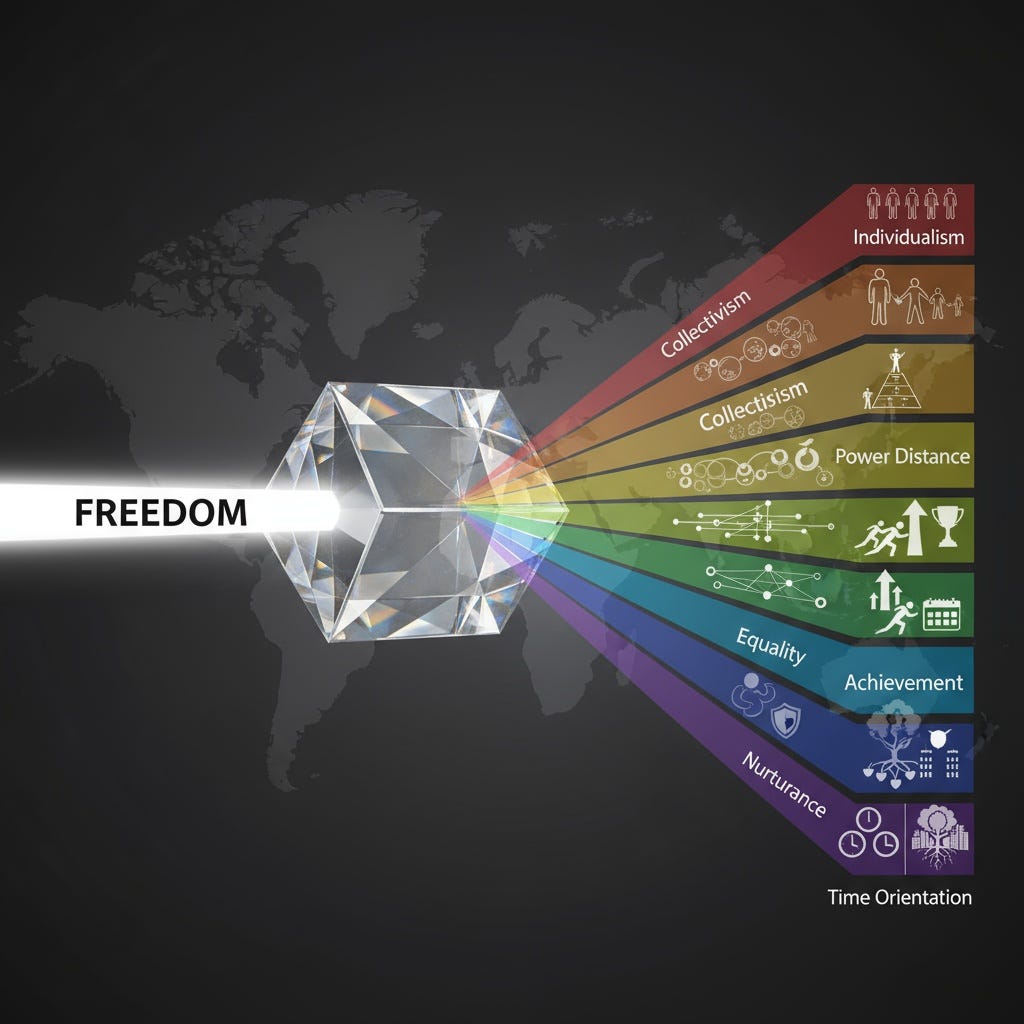Monday Edition — Freedom Is Not A Thing. It's What Your Culture Tells You It Is.
Freedom Isn’t What You Think It Is — A Cultural Analysis
Freedom in the U.S. and much of the West is often discussed as something you either have or don’t have. Some countries are free, while others are not free. Of course, it is not that simple. Freedom is a deeper concept, and while freedom is often spoken of as if it means the same thing everywhere, a universal human desire, a political ideal, a natural right - it is not.
Freedom is what you are told it is by your culture.
And that means the definition of freedom, what people actually think freedom is, and the freedoms they want can be vastly different. You will see in this week’s series that one person’s freedom is another’s authoritarian oppression or that one person’s freedom is another’s unlivable chaos.
Two Faces of Freedom
Political philosopher Isaiah Berlin described two basic kinds of freedom:
”Positive” freedom - The freedom to
“Negative” freedom - The freedom from
Freedom to
The freedom to act, to speak, choose, build, or dissent, this is the version most familiar in individualistic societies. It focuses on individual agency, being able to pursue one’s goals, to do what one wants, without interference.
“Positive” freedom expresses the value of mastery, control over one’s environment and destiny (Schwartz’s “Mastery” value). This fits individualistic, achievement-oriented, low-context cultures that prize autonomy and self-determination.
Freedom from
The Freedom from fear, want, or exclusion is the version emphasized in collectivist-oriented societies. It values security and social protection, the assurance that no one is left behind.
This is the freedom from external constraints such as oppression, fear, or need.
It emphasizes security and protection, not choice for its own sake.
In many European and East Asian societies, freedom means being free from hunger, illness, unemployment, or insecurity, even if that requires collective systems or limits on personal autonomy.
“Negative” freedom reflects the value of harmony, balance and protection for everyone over the freedom to impose on others (Schwartz’s “Harmony” value). This fits collectivist, nurturance-oriented, high-context cultures that value social responsibility.
Both forms of freedom come from a society’s cultural perspective, and people determine what freedoms they want by balancing these two concepts. No nation’s concept of freedom is right or wrong, they are just different.
Freedom to and freedom from appear differently in every culture. Hofstede’s dimensions help explain why: each society balances autonomy, responsibility, and security in its own way.
This Week
This week, we’ll examine freedom through Hofstede’s cultural dimensions and a few complementary perspectives from Trompenaars, Hall, and Schwartz, to see how those deeper values shape what freedom means across the world.
Tuesday: Individualism vs. Collectivism — Who is freedom for?
We’ll look at how some cultures define freedom as independence, the right to act without permission, while others see it as harmony, the right to live without conflict. Freedom’s meaning depends on whether the individual or the community is the focus.
Wednesday: Power Distance & Uncertainty Avoidance — Who is in charge of freedom and how much freedom feels safe?
We will explore how hierarchy and fear of uncertainty shape the limits of freedom. In some societies, order is what protects liberty; in others, it’s what destroys it.
Thursday: Achievement vs. Nurturance — Competing or caring.
Freedom can mean the right to achieve or the right to live without pressure. Cultures that prize achievement see liberty in ambition, while those that prize nurturance see it in security and balance.
Friday: Time and Desire — Freedom as direction: for today or for tomorrow.
Some cultures express freedom through indulgence, to live fully now, while others express it through restraint and foresight, building for the future. The contrast reveals how time itself becomes a cultural expression of freedom.
Saturday: The Core Brief — The Cultural DNA of Freedom.
The week concludes by tracing how every society encodes freedom in its values, autonomy, harmony, stability, or compassion, and why misunderstanding these differences creates misunderstanding and conflict.
Across these dimensions, freedom shifts from personal to collective, from external to internal, from action to understanding.
In some regions, freedom is protected by rules; in others, it is preserved by relationships.
One culture’s freedom fighter can be another’s threat to order.
Hornby’s Archetypes
M. J. Hornby’s archetypes show how internal drives mirror collective values, how psychology meets culture in defining freedom.
North — The Power-Seeker sees freedom as the power to lead and decide. Freedom means authority without interference, autonomy at the top.
South — The Worker sees freedom as security through labor and survival. Freedom means the ability to earn, to work without exploitation.
West — The Sage sees freedom as the pursuit of truth and knowledge.
Freedom is the right to think independently and to question.
East — The Communicator sees freedom as the ability to share and connect ideas. Freedom means open dialogue, mutual understanding, and open and equitable exchange.
Blue — The Guardian sees freedom as order and righteousness. Freedom means moral clarity, the right to uphold what is right, and to protect tradition and personal values.
Red — The Mother sees freedom as emotional expression and belonging. Freedom means to love, nurture, and be accepted as one chooses.
Yellow — The Creative sees freedom as self-expression without constraint. Freedom means to imagine, create, and live authentically without judgment.
Green — The Caregiver sees freedom as the ability to help and sustain others.
Freedom means compassion in action and care for everyone.
So before we can talk about defending freedom, we need to ask a simpler question:
What kind of freedom are we talking about? Are we defending the freedoms we want or the freedoms they want?
This week, we’ll find out.
Join us for more cultural perspective on TikTok and YouTube





